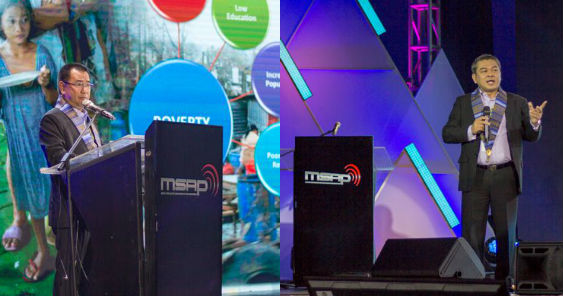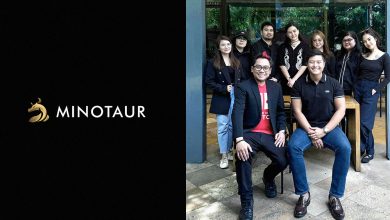From handkerchieves, coconut husks, or bras, Pinoys now keep their money in coin purses and wallets. This is how Leyte Gov. Dominic Petilla demonstrated the state of the Filipino’s wallet during his back-to-back discussion with University of the Philippines School of Statistics dean, Dr. Dennis Mapa, at the Media Specialists Association of the Philippines (MSAP) Ascendant: The 2017 Media Congress in Baguio City.
Gov. Petilla and Dr. Mapa went back-to-back to discuss the ‘State and Share of the Filipino’s Wallet’. Gov. Petilla shared the Leyte Economics program which helped revitalise and grow the province’s economy since it was ravaged by Typhoon Yolanda back in 2013. Meanwhile, Dr. Mapa went deep into the aspirations of the Filipinos, their income and expenditure, the demographic dividend, and the challenges and policy issues faced by government and the society with the economic state of the Filipino people.
Here are our key takeaways:
1. The greatest economic resource is people.
After the devastation brought by Typhoon Yolanda in 2013, the provincial government of Leyte sought to rebuild and revitalize the province through economic growth. The Leyte Economics Program led by Gov. Petilla turned poor communities in the province into producers of agricultural goods and services.
“The greatest resource is our people. People are the ones who produce. They are the ones who do things,” Gov. Petilla stressed. The program focused on human development efforts like health initiatives and nutrition, education, and values formation. Under the program, communities were trained on farming, livestock production, fisheries, technical skills, environmental protection, and disaster preparedness. The provincial government also provided infrastructure support to facilitate production and transport of goods.
Because of the Leyte Economics Program and the emphasis on human development, the province contributed to the 4.6% regional GDP growth of the Eastern Visayas region, making it the 5th fastest growing regional economy out of the 17 regions of the country. Leyte’s regional poverty dropped by 6.7% in 2016, just three years after Typhoon Yolanda struck. Furthermore, Leyte’s economic growth reached double digits at 12.4%.
2. Filipinos aspire to have a simple and comfortable life.
Dr. Mapa presented AMBISYON 2040 which represents the long-term vision and aspiration of Filipinos for themselves and for the country in the next 25 years. A huge number of Filipinos at 79% aspire to for a simple and comfortable life, while 17% want a well-off life, and quite a small number at 4% dream of the rich life.
According to the survey, the definition of a simple and comfortable life is having a medium-sized home, enough earnings to support everyday needs, owning at least one vehicle, the capacity to provide college education for children, and going on local trips for vacation.
However, this life might not be so simple after all, since a household should be earning at least P120,000 per month or P1.44M per year to attain and keep the lifestyle.
3. The state and share of the Filipino’s wallet varies across income class.
According to Dr. Mapa, the state and share of the Filipino’s wallet differs among income classes.
Citing numbers from Philippine Statistics Authority data, Dr. Mapa pointed out that the Filipino wallet receives an average annual income of around P267,000, far from the P1.44M needed to have a simple and comfortable life. Data also showed that average monthly income from 2012-2015 grew by 31.5% while average expenditure growth is at 3.66% per year within the same period.
As for the share of the wallet, Filipino households mostly spend on food and house rental. However, the share of food expenditure for the bottom 30% households is highest among expenditure items at 59.7% versus 38.8% for the top 70% households. On the other hand, the top 70% or middle-income households spend more on house rental than the bottom 30% at 13% versus 7.7%. Filipino households spend P4,883B with a split of P4,152B spent by the top 70% while P730B is spent by the bottom 30%.
4. The state and share of the Filipino’s wallet depends on demographic structure.
The ‘Goldilocks’ Period’ is the time when a country reaches the demographic sweet spot which pays out the demographic dividend. When countries move from having a high fertility rate to a low fertility rate, they undergo a demographic transition and hits the demographic sweet spot, which is a generation where fertility is neither too high nor too low. At this point in time, the country reaps the demographic dividend or extra income from a highly productive population.
The phases of the demographic transition are divided into three. The first phase shows a high dependency group (0-14 years old). At this time, the government invests more in health and education. During the second phase, the young dependents move on to enter the working age group. This is when the population’s productivity and income growth is high. Finally, the third phase sees the swelling of the elderly age group which features both expenditure and income growth. Individuals save up during their working years to prepare for retirement.
According to Dr. Mapa, while the Philippines has a unique opportunity to generate productivity and income because of its young population (median age of 23), the country is still in the first phase, where there is a big dependency group. As such, the government mostly still spends on health and education rather than invests on programs which promote economic growth.
5. High fertility rates and high unemployment and underemployment rates remain to be the biggest challenges to growth.
The country stands to benefit from its young population as there are more people entering the workforce and increasing productivity. Yet, the Philippines face two challenges: slow reduction in high fertility rate especially in poor households and high unemployment and underemployment rates among young workers, particularly in the 20 to 24 year-old group.
The country will not be able to reap the demographic dividend nor take advantage of the increasing number of young people entering the work force if they are not employed in productive labor. One reason for high youth unemployment is job-skills mismatch.
Government should put policies in place to take advantage of the demographic sweet spot. It should be ready to facilitate the movement of people entering the work force into productive jobs that match their skill set. Dr. Mapa reminded that the demographic dividend is not automatic. It only pays off when conditions are right, and government must do its job in making it so.









